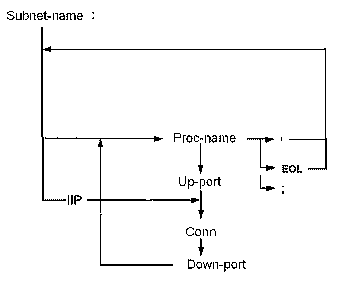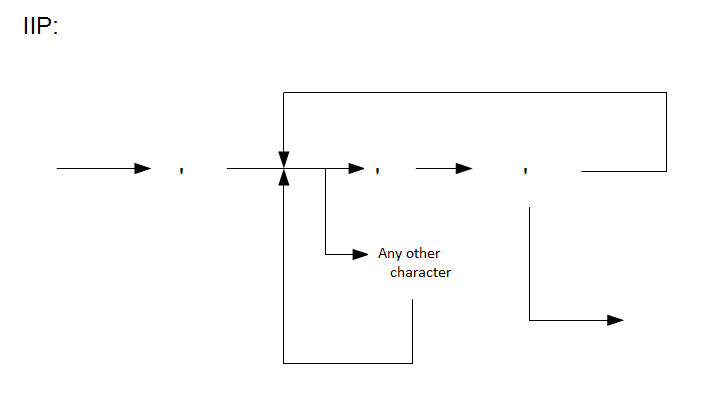This chapter has been excerpted from the book "Flow-Based Programming: A New Approach to Application Development" (van Nostrand Reinhold, 1994), by J.Paul Morrison. A second edition (2010) is now available from CreateSpace eStore and Amazon.com. The 2nd edition is also available in e-book format from Kindle (Kindle format) and Lulu (epub format). To find out more about FBP, click on FBP.
For definitions of FBP terms, see Glossary.
|
The THREADS package, mentioned in the 1st edition, was converted to use Windows "fibres" and C++ a few years ago. However, fibres did not seem sufficiently general, so this package is now in process of being converted to use Boost, to take advantage of Boost multithreading. This process is ongoing (as of May 2014), and is described in CppFBP and Lua Interface. The earlier, fibres-based, version is still available as a zip file.
Material from first edition of book starts here:
In Chapter 23, we described the THREADS notation for linking components into networks - this will also be repeated below in summary form. However, perhaps even more important are the conventions for writing components, as these are what will allow independently developed components to be combined into a single network without the requirement that they be developed by the same person or even in the same location (apart from the normal requirements for consistency of IP and stream formats).
Here is a simple component written in C++ to copy IPs from IN to
OUT.
Let's call this rather unoriginally ThCopy.
A THREADS component is a regular C++ subroutine, so, as you might expect, the first few statements are the declares.
|
The first action is always to initialize the port table using a call
to dfsdfpt
- the 2nd parameter of the call to dfsdfpt
must match the dimension declared for the port table. This number must
also match the number of port names specified in the parameters to dfsdfpt
. Note: dfsdfpt modifies the port table, so this must not
be defined as constant.
The return statement causes deactivation (but not necessarily termination, as described above). The return code value on the return statement determines whether the process is willing to be reactivated: a value of 5 or greater forces termination even if data is available.
API Calls:
Here are the API calls available to components in THREADS:
Create a Packet:
|
Parameters:
Note that the ptr, size, type and port table element
parameters all have &'s attached, except in the case of dfscrep
, where only ptr has it. The &'s are required
because
these parameters may be modified, and C parameters are all passed by
value
(except for strings and arrays). In some cases a particular service
does
not set them, but for consistency &'s are used for all of
them
(except dfscrep ).
port_count and elem_no are all binary integer
variables
(int). size is binary long. dfscrep is
restricted
to a maximum of 64000 bytes.
-
proc_anchor: a variable of type anchor (defined inthxanch.h) -
ptr: a void pointer used to point at IPs -
size: a long variable containing the IP's size -
type: a null-terminated string of up to 32 chars -
port_count: parameter todfsdfpt- must match the dimension of the definedport_tabarray for this component -
elem_no: this specifies the element of the appropriate port to be used in a send, receive or close. These are only required for array-type ports, where they number up from 0. For non-array ports, this parameter must be 0. -
port_tab: this parameter is declared as an array of typeport_ent(see below), where each element corresponds to one of the ports known to the component; the whole structure is passed todfsdfpt, while specific elements ofport_tabare passed tosend,receiveandcloseusing&. -
port_name_n: port name to be used bydfsdfpt; the number of these must match theport_countparameter
All pointers in the following declarations are "far" pointers.
Declare for port_ent:
struct _port_ent
|
After a call to dfsdfpt, elem_count in each port_ent
instance will
be set to the number of connected elements for that port, and ret_code
will
be set to 0 or 2, depending on whether that port was connected or not.
Declare for anchor (thxanch.h):
struct _anchor {
|
Service return codes:
dfscrep:
|
Limitations:
There is a limit of 4000 elements per array port.
Working storage for a component should not exceed a few thousand
bytes (including the working storage of any subroutines it calls). If
the component needs more than this, it should use one of C's dynamic
allocation functions (e.g. malloc or calloc) to
allocate the additional storage.
Network Notation
Networks are defined initially using a free-form notation, described briefly in Chapter 23. For instance,
'data.fil'->OPT Reader(THFILERD) OUT -> IN Selector(THSPLIT) MATCH -> ...,
|
The general syntax for networks is quite simple, and can be shown as follows (using a variant of the flow notation which has started to become popular for defining syntax):

I have labelled the ports above and below the connection indicator (arrow with optional capacity figure) "up-port" and "down-port" to indicate that they are upstream and downstream, respectively, of the connection.
The main network may be followed by one or more subnets, which have
basically the same notation (each one starting with a label and
finishing
with a semi-colon). However, subnets have to have additional notation
describing
how their external port names relate to their internal ones. Since this
association
is like an equivalence, we use the symbol => to indicate
this relationship. Thus,
, port-name-1 => port-name-2 process-A port-name-3,
|
indicates that port-name-1 is an external input port of
the subnet,
while port-name-2 is the corresponding input port of
process-A. Similarly,
, port-name-1 process-A port-name-2 => port-name-3,
|
indicates that port-name-3 is an external output port of
the subnet, while port-name-2 is the corresponding output
port of process-A. For an example, see the example of subnets given in
Chapter 23.
Other syntactic elements:

Two consecutive quotes are taken to mean a single quote.

element-number does not apply to the external port names of
subnets. The asterisk indicates an automatic port (see Chapter 13).

capacity does not apply to the external port names of
subnets.

The component name can be specified on any occurrence of the process name. The question mark indicates that tracing is desired.
In Chapter 13 we alluded to the fact that we can specify that a
process "must run at least once" - this is specified by means of an
attribute file for the component, which has the name of the component,
and an extension
of atr, e.g. thcount.atr. These files must be
provided by the supplier of
a component, and must have a specific format. So far, only the "must
run"
attribute has been defined - it is specified by coding one of the
character
strings must_run, Must_run or MUST_RUN,
with optional preceding blanks, in
the attribute file for a given component. If no attribute file is found
for a component, default values are assumed to apply (the default for
the
"must run" attribute is "need not run").
As mentioned in Chapter 23, there is also a compiled (or compilable)
format for specifying networks - while this is obviously not
appropriate
for hand-coding by human users, it is easy enough to generate by means
of
software. It is a data-only C program, and specifies a network,
together
with all referenced subnets. Its importance is that this will be the
source
form for networks owned by customers, so THREADS must guarantee that
any
enhancements to it will be upwards compatible. These guarantees are
essentially
encoded in the C headers which it uses: thxiip.h, thxanch.h
and thxscan.h.
thxanch.c has been given above. The other two are defined
as follows:
thxiip.h
|
thxscan.h
|
Note: the above structures are not the internal control blocks of THREADS - they are an encoding of the free-form network specification notation. This separation will allow THREADS to be extended in the future without requiring network definitions to be reprocessed.